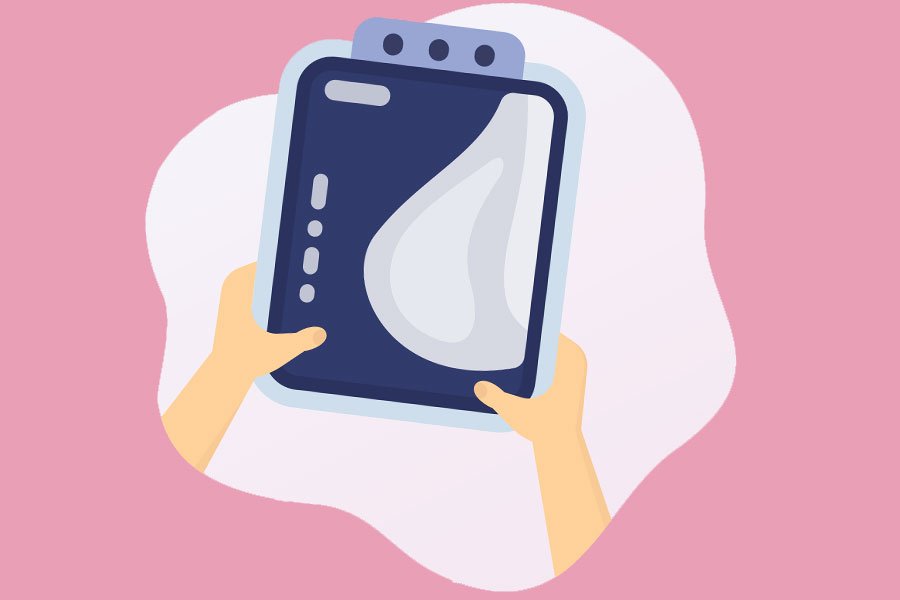Don’t Miss Your Mammogram

The more you know, the healthier you’ll be. Here’s everything you can expect from your mammogram: before, during, and after.
It’s widely known that a routine mammogram is key for early breast cancer detection. But many women put off this crucial screening out of fear that it’ll hurt or worse, that they’ll find out they have cancer. The pandemic added an additional barrier to screenings—a study from the American Cancer Society found a 6 and 11 percent dip in breast and cervical cancer screenings, respectively, between 2018 and 2020. In March and April 2020 alone, those screenings fell by nearly 80 percent.
If you’ve missed your mammogram or delayed your first screening, it’s time to make that appointment. To help get you ready for your visit, we’ve developed this guide to answer any questions you may have.
How should I prep for my appointment?
There’s not much to do before your mammogram appointment, but if you still get your period, it’s best to schedule it the week or two aft er, when your breast tissue is less sensitive.
On the day of, do not wear any powder, deodorant, or lotion under your arms; it can be misread as calcifications on your
film. And for your own comfort, wear a top and bottom; you’ll need to remove your top and wear a gown during your screening.
What happens during a mammogram (i.e., does it hurt)?
A mammogram is a low-radiation X-ray that can reveal tumors, process takes about 10 to 20 minutes. During the screening, a technician will place your breast between two plates, one at a time, and then it is briefly compressed. If you’re afraid it hurts, know that it can be uncomfortable for some, but shouldn’t be painful.
When should I start getting mammograms?
A woman at average risk for breast cancer— meaning she doesn’t have a personal history of breast cancer, strong family history, or a genetic mutation that increases her risk— can start screenings between the ages of 40 and 44. Women between the ages of 45 and 54 should have mammograms annually. Over 55, women can opt for a mammogram every other year.
Higher-risk women—those with a family history, genetic mutation, high breast density, or personal breast cancer history—
should begin routine screening before the age of 40. Talk to your doctor to determine whether or not you are high risk.
Are there different types of mammograms?
Yes! There are two types of mammography machines: 2D and 3D (or digital breast tomosynthesis). While 2D mammograms are effective, 3D mammograms are bett er at detecting breast cancer and are less likely to have false positives. According to the FDA, 83 percent of facilities now off er this option in at least one of their mammography units.
In addition to a mammogram, your doctor may also order ABUS, or an automated breast ultrasound— especially if you have dense breasts. ABUS allows radiologists to see the breast from multiple angles and can detect 30 percent more cancer in women with dense breasts. During the painless process, the technician puts a gel on each breast and then runs a scanner over them. The procedure takes about 15 minutes.
What does it mean to have dense breasts?
The breast is made up of three different types of tissue: fibrous connective, glandular, and fatty. Breast density refers to the amount of fibrous and glandular tissue compared to fatty tissue. According to the Centers for Disease Control and Prevention:
- About 10 percent of women have breasts that are almost entirely fatty
- About 40 percent have a few areas of dense tissue scattered throughout the breast
- About 40 percent are evenly dense
- About 10 percent are extremely dense
The last two categories are considered dense enough that they pose a higher risk. Women with dense breasts are four to six times more likely to get breast cancer, and a Journal of the American Medical Association study found that 35 percent of cancer goes undetected in women with dense breasts.
What if I get called back?
Deep breath. Getting the call that you need a follow up or diagnostic screening is incredibly stressful, but not uncommon. Around 10 percent of women require additional screening, which can include a 3D mammogram, ABUS, or a breast MRI. Of those women, only one in 10 ultimately get a breast cancer diagnosis.
This is a paid partnership between Think Pink and Boston Magazine


